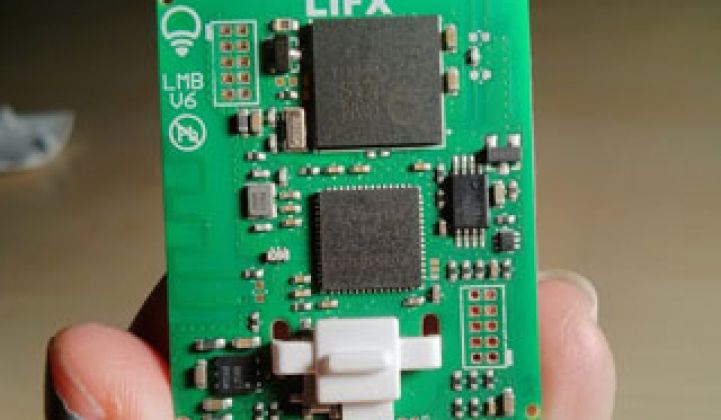Last week, General Electric announced a new connected light-emitting diode bulb for the mass market that's available at a lower price point than its competitors have offered so far.
More bulbs will likely follow, and more consumers will make the switch to wireless LEDs that can be controlled via a computer or smartphone. With the proliferation of affordable, connected LEDs, however, comes the opportunity for hackers to attack yet another node in the household.
Researchers at the U.K. firm Context Information Security recently hacked an LIFX Wi-Fi LED network, taking control of the bulb and gaining access to the mesh and Wi-Fi network that the bulbs were connected to. LIFX light bulbs are one of the first products to have integrated with Google’s Nest home platform.
"Of course, as with any internet connecting device, whether phone, laptop, or light bulb...there is always a chance of someone being able to hack it,” Alex Chapman, senior security researcher at Context, wrote in a blog post.
His firm told Engineering and Technology magazine that it took six researchers to hack the bulbs.
The team began by monitoring the 6LoWPAN network that the bulbs use to connect to each other. Once they installed a device to monitor and inject traffic into the LIFX mesh network, Context researchers were able to control the light bulbs. The mesh network appeared to be unencrypted.
Once they had infiltrated the mesh network, the researchers identified the specific packets in which the Wi-Fi network credentials were shared amongst the bulbs. They could request the Wi-Fi details, even though they weren’t adding a new bulb, which did not raise any alerts with the LIFX smartphone application. Although they could request the information, at this stage they could not decrypt the Wi-Fi credentials.
The next step was to hack the Wi-Fi network. Context extracted the firmware, a project that involved splitting the case open with a hammer. Ideally, they noted, a hacker could simply download the firmware from the vendor website without having to resort to physically cracking into the hardware.
The team then needed some more hardware and software to issue commands directly onto the chip. Once that was in place, “we can merrily dump the flash memory from each of the chips and start the firmware reverse-engineering process,” wrote Chapman.
After extracting the encryption variables to decrypt the Wi-Fi, Context researchers had all of the pieces they needed. They could hack into the mesh network, get the Wi-Fi details and then decrypt those credentials without any alarms going off in the lighting network.
"Hacking into the light bulb was certainly not trivial, but would be within the capabilities of experienced cyber criminals," Michael Jordon, research director at Context, said in a statement.
Context noted that LIFX was proactive in its response and has already updated its firmware and added encryption to its 6LoWPAN network.
Another important caveat is that hackers looking to break into an LED network like this would need to be within wireless range of about 100 feet in order to access the 6LoWPAN network. In other words, a large-scale attack on wireless LED networks would be largely impractical.
But it is not just the billions of network-enabled consumer devices going into the home that will require more stringent security protocols.
LEDs are already being widely adopted by cities, particularly for street lighting, and will dominate that market by 2023, according to Navigant Research. As more of those are networked, and the networks are used for more than just lighting, cities will have to carefully consider the security of the systems they choose.
"It is clear that in the dash to get onto the [internet of things] bandwagon, security is not being prioritized as highly as it should be in many connected devices," said Jordon. "IOT security needs to be taken seriously, particularly before businesses start to connect mission-critical devices and systems."



